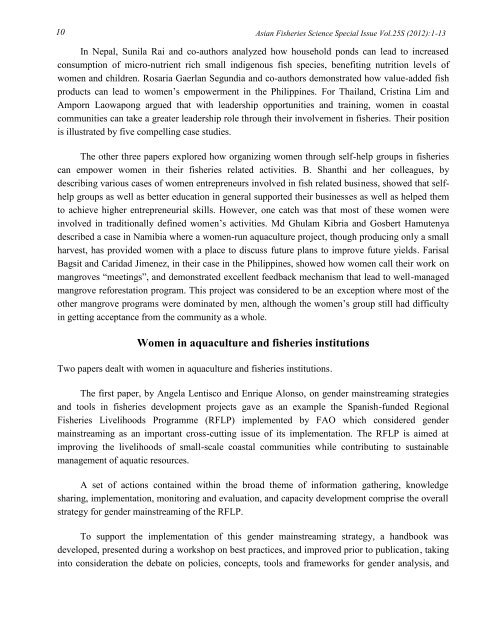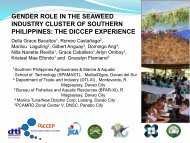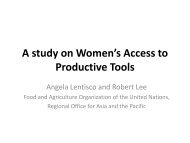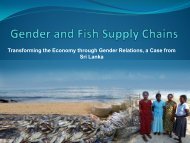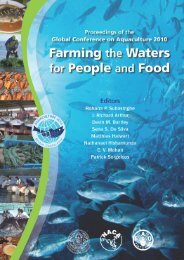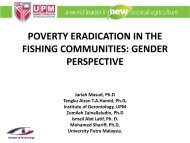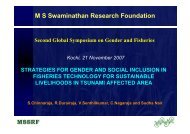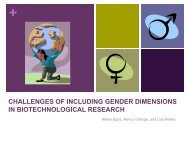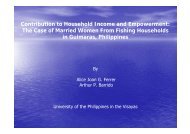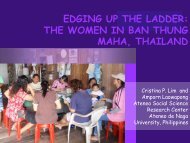Moving the Agenda Forward - GENDER IN AQUACULTURE AND ...
Moving the Agenda Forward - GENDER IN AQUACULTURE AND ...
Moving the Agenda Forward - GENDER IN AQUACULTURE AND ...
Create successful ePaper yourself
Turn your PDF publications into a flip-book with our unique Google optimized e-Paper software.
10Asian Fisheries Science Special Issue Vol.25S (2012):1-13In Nepal, Sunila Rai and co-authors analyzed how household ponds can lead to increasedconsumption of micro-nutrient rich small indigenous fish species, benefiting nutrition levels ofwomen and children. Rosaria Gaerlan Segundia and co-authors demonstrated how value-added fishproducts can lead to women’s empowerment in <strong>the</strong> Philippines. For Thailand, Cristina Lim andAmporn Laowapong argued that with leadership opportunities and training, women in coastalcommunities can take a greater leadership role through <strong>the</strong>ir involvement in fisheries. Their positionis illustrated by five compelling case studies.The o<strong>the</strong>r three papers explored how organizing women through self-help groups in fisheriescan empower women in <strong>the</strong>ir fisheries related activities. B. Shanthi and her colleagues, bydescribing various cases of women entrepreneurs involved in fish related business, showed that selfhelpgroups as well as better education in general supported <strong>the</strong>ir businesses as well as helped <strong>the</strong>mto achieve higher entrepreneurial skills. However, one catch was that most of <strong>the</strong>se women wereinvolved in traditionally defined women’s activities. Md Ghulam Kibria and Gosbert Hamutenyadescribed a case in Namibia where a women-run aquaculture project, though producing only a smallharvest, has provided women with a place to discuss future plans to improve future yields. FarisalBagsit and Caridad Jimenez, in <strong>the</strong>ir case in <strong>the</strong> Philippines, showed how women call <strong>the</strong>ir work onmangroves “meetings”, and demonstrated excellent feedback mechanism that lead to well-managedmangrove reforestation program. This project was considered to be an exception where most of <strong>the</strong>o<strong>the</strong>r mangrove programs were dominated by men, although <strong>the</strong> women’s group still had difficultyin getting acceptance from <strong>the</strong> community as a whole.Women in aquaculture and fisheries institutionsTwo papers dealt with women in aquaculture and fisheries institutions.The first paper, by Angela Lentisco and Enrique Alonso, on gender mainstreaming strategiesand tools in fisheries development projects gave as an example <strong>the</strong> Spanish-funded RegionalFisheries Livelihoods Programme (R FLP) implemented by FAO which considered gendermainstreaming as an important cross-cutting issue of its implementation. The RFLP is aimed atimproving <strong>the</strong> livelihoods of small-scale coastal communities while contributing to sustainablemanagement of aquatic resources.A set of actions contained within <strong>the</strong> broad <strong>the</strong>me of information ga<strong>the</strong>ring, knowledgesharing, implementation, monitoring and evaluation, and capacity development comprise <strong>the</strong> overallstrategy for gender mainstreaming of <strong>the</strong> RFLP.To support <strong>the</strong> implementation of this gender mainstreaming strategy, a handbook wasdeveloped, presented during a workshop on best practices, and improved prior to publication, takinginto consideration <strong>the</strong> debate on policies, concepts, tools and frameworks for gender analysis, and


